
Guest blogged by Mewa Singh
I did not think I was going to write this post, but after seeing a post on the most popular South Asian American blog – Sepia Mutiny – by Amardeep Singh, I had to make a comment about Musharraf’s resignation to avoid impeachment.
For a quick primer on the career of the Pakistani dictator – Pervez Musharraf, watch the Al-Jazeera video:

Is the tipping point (the level at which the momentum for change becomes unstoppable) approaching for a change in attitudes towards the value of women and need to have sons?
There has been a widespread, public movement condemning sex-selection by the government, ngos, and others in the community for some time now (this hard-hitting song by Sarabjit Cheema is a must-see). Since Amartya Sen’s articulation of ‘missing women,’ the rights of women in developing countries have been at the forefront of international agendas. In a recent development, Sunita Rao, an Indian pop singer, has released a song condemning sex-selective abortion and become the spokesperson for the LAADLI campaign, funded by the United Nations Population Fund.
Suneeta Rao’s latest album WAQT’s press conference was held in Hotel Palace Heights, New Delhi. It was on behalf of United Nations Population Fund (UNFPA). The singer is the official spokesperson of the Laadli campaign of UNFPA that focuses on the pleasure and pride of having a daughter and motivates people to fight injustice against the girl child. ‘The video of the first song in my album ‘Sun Zara’ is a dedication to all girls, Suneeta said, UNFPA has gratefully supported in making the video of this album. According to United Nations Population Fund, “This video has been made for the Girl Child, to address the issue of Sex Selection and to help stop female feticide”. [link]
The song mentioned above, Sun Zara:
 I was in London last week and stopped off in Hounslow, Ealing and Southall to just walk about and visit family. In the past 50 years, Southall has become a huge pass-through and historic cultural and political center for Punjabis, especially Indian and Sikh Punjabis, in London and the greater UK. I visited the neighborhood a few years ago, and I looked forward to returning.
I was in London last week and stopped off in Hounslow, Ealing and Southall to just walk about and visit family. In the past 50 years, Southall has become a huge pass-through and historic cultural and political center for Punjabis, especially Indian and Sikh Punjabis, in London and the greater UK. I visited the neighborhood a few years ago, and I looked forward to returning.
I was a little surprised to see that the neighborhood had changed. In addition to taking on an ever-growing refugee population from Somalia, there seemed to be a growing Sikh Punjabi underclass. Southall, historically, has been populated by working- and middle-class desis, and with that comes a variety of concerns around resource availability, support, language and social services, etc. Multi-family or multi-worker flats and apartments are not uncommon, but I was surprised by the increased concentration of subpar worker housing. Instead of the more prevalent norm of helping out new immigrants by sheltering them and helping them acclimate to London, there seemed to be a small (but growing) formation of Punjabi-run slum housing, similar to the exploitative workers’ ghettoes and communities of New York in the early- to mid-1900s.
I was really distressed by this development; Southall has amazing local institutions that are nationally and internationally reknowned for their civic engagement and dedication. In many ways, it is the face of the UK Sikh community, for better or worse. I’m not naive; I know that our community has deep and complicated internal issues and challenges. How do we begin to address these basic issues of justice, their connection to Sikhi, and what this means for the reputation and behavior of the community as a body? I don’t think we should dictate or micro-manage people’s behavior, but I do think it’s important to have begin to create ways to mediate conversations and norms/attitudes around how Sikh ethics translate into practice.
Some of you may have followed the case of Sarika Singh, a Welsh-Sikh student who was barred from school when the organization adopted a dress code that prohibited wearing jewelry, including religious items. Instead of conforming to the dress code or transferring schools, Singh appealed to the school. When officials refused to reverse their decision or provide exception for the kara (not an item of jewelry, but rather an article of faith), Singh sued under the UK’s anti-discrimination laws. She has been excluded from classes and from attending school for the past nine months.
Moments ago, the BBC reported that the UK’s High Court affirmed her case, stating that the dress code unfairly burdened Singh’s freedom of religious expression. Both advocates and the court expressed frustration with the school, stating that the issue had been clearly defined in U.K. statutes and case law for over 20 years. This judgment opens the door for students of all religious backgrounds; in addition to the banning of the kara, other UK (private) schools have moved to ban the crucifix, the hijab, and the yarmulke. Against this “confining” interpretation of secularism (an interpretation more common on the European continent), the UK courts have clarified the intent of the country’s inclusionary and anti-discriminatory legal framework.
We’ll continue to update with details and analysis as information becomes available.
All the headlines are centered on the news of the capture of Bosnian Serb wartime president, Radovan Karadzic. Karadzic has been indicted for genocide in the Bosnia war. Apprehended by government officials, a change in political winds in Serbia now-seeking EU membership has allowed for the present Serbian government to capture the thirteen-year fugitive. The world is now waiting for Karadzic to be transferred to The Hague to  face trial.
face trial.
Karadzic’s soon-expected extradition and last week’s International Criminal Court (ICC) prosecutor request that genocide charges should be brought against Sudanese President Omar al-Bashir for state-sponsored pogroms in the Darfur region of Sudan is being watched the world over.
Karadzic’s arrest led to one Munira Subasic, head of a Srebrenica widow’s association (for more information on the Srebrenica Genocide/Massacre, click here), stated
“[Karadzic’s arrest] is confirmation that every criminal will eventually face justice.” [link]
I hope Subasic’s comments ring true. While I celebrate the capture of one tyrant, as a Sikh, my attention wanders (as it tends to) to the situation in Punjab and the Indian State.
A recent French decision brings debates about multiculturalism and accommodation back into focus. France’s highest administrative court prevented the wife of a French national and mother of 3 French- born children from obtaining French citizenship based purely on her wearing of a niqab– for “insufficient assimilation” into France:
…last month, France’s highest administrative court upheld a decision to deny citizenship to Ms. Silmi, 32, on the ground that her “radical” practice of Islam was incompatible with French values like equality of the sexes. [link]
The decision received support from some French-Muslim officials who do not support women’s wearing of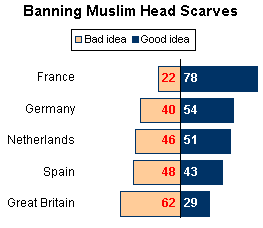 niqabs.
niqabs.
The ruling on Ms. Silmi has received almost unequivocal support across the political spectrum, including among many Muslims. Fadela Amara, the French minister for urban affairs, called Ms. Silmi’s niqab “a prison” and a “straitjacket.” “It is not a religious insignia but the insignia of a totalitarian political project that promotes inequality between the sexes and is totally lacking in democracy,” Ms. Amara, herself a practicing Muslim of Algerian descent, told the newspaper Le Parisien in an interview published Wednesday. [link]
There are major differences between the niqab and Sikh religious dress. The objection to the niqab that it’s incompatible with the French value of equality of the sexes doesn’t carry over to Sikh dress. The dastaar or pag doesn’t pose the same dilemma as both men and women may wear it, and it is not seen as an inhibition on gender equality generally.
For many Sikhs the name Sumedh Saini rings a solemn tone. Part of a handful of high police officials, Saini was the Superintendent of State Police in Chandigarh during the Troubles in Punjab. He reigned with fear, terror, and impunity.
 While the wheels of justice may be slow, the Central Bureau of Investigation (CBI), India’s premier investigating agency, has just released its indictment of Sumedh Saini. Saini has recently been indicted for abduction, illegal detention, and other offenses. While the charges pale against the thousands of ‘eliminations,’ for some they are taking solace for the CBI’s findings.
While the wheels of justice may be slow, the Central Bureau of Investigation (CBI), India’s premier investigating agency, has just released its indictment of Sumedh Saini. Saini has recently been indicted for abduction, illegal detention, and other offenses. While the charges pale against the thousands of ‘eliminations,’ for some they are taking solace for the CBI’s findings.
Total of four people were indicted by the CBI on Friday:
State Vigilance Bureau chief Saini, retired former Chandigarh DSP Baldev Singh Saini, Chandigarh SHO (Station House Officer) and ex-subinspector Harsahai Sharma and former subinspector now SHO Jagir Singh [link]
The findings are significant in face of his plum appointed position by Punjab Chief Minister, Parkash Badal, who had raised him to the head of the state’s Vigilance Bureau. While it will have little political traction, it points to the hypocrisy of the ‘banana republic’ that is the state of Punjab where the head of a bureau meant to guard against corruption is now being indicted for falsely arresting and torturing the state’s citizens.
Mr Saini is currently leading the Parkash Singh Badal government’s campaign targeting former chief minister Amarinder Singh and his associates. The CBI’s charges against him have come as certain embarrassment for the chief minister. [link]
It is still to be seen what will come from all this, will Saini actually be convicted and punished for his crimes? or will this just be another CBI indictment?
The UK has been hit with a recent controversy over expenditures, allegedly upwards of £100,000, spent on finding appropriate anti-terror gear that could accommodate the Sikh turban. A good deal of this was spent taking the officer away from duty and asking him to approach equipment manufacturers himself to request accommodated gear. Shortly after this search period expired, he took a leave in order to cope with the emotional stress of this experience.
Two very salient arguments are made: One side argues that such cost was a “waste” and took the officer in training away from assignment (he was in limbo — he was not able to serve with the regular police, but without a uniform could not get full clearance to serve with anti-terror specialists). The other argues that the officer is sorely needed, that the county he hails from is actively trying to diversify its anti-terror police force, and that the cost is worth it if it paves the way for other ethnic and religious minorities to feel comfortable trying out to join the anti-terror squadron.
I think there’s validity to both arguments. Accommodation, especially in democracies, ought to be a key value in integrating diverse communities. That said, it sounds like the UK (or local) government did not take the issue of diversity seriously. The problem is not in the £100,000, per se, it’s in the failure of the state to actively support, or deal seriously with, the issue of Sikh guards.
But is there ever a (monetary) limit to accommodation? How do we find that limit? Is it a simple cost-benefit analysis, or are there other, more weighted, measures that come into play? Was it the money itself, or the poor management of said money?
I had a long and interesting conversation with a friend of mine this weekend on different attitudes towards finance and charity between different world religions. We noted that both Judaism and Sikhi require a 10% charitable contribution, in addition to service, which has no upper or lower bound and serves a different purpose. This dovetailed with a conversation I had with a few friends, including one who is an Islamic banker in Dubai, about religious concepts of usury, interest, and charity.
For many low-income and poor communities, asset/wealth creation is a major hurdle, and access to financial/resource markets and services is non-existent. Although Sikhi has strong proscriptions against materialism, greed (moh), and attachment (maya), it also has a redistributive element. While simplicity is embraced, wealth is not necessarily wholly eschewed (if earned honestly and put to just uses).
If a financial institution were opened upon Sikh principles, what would it look like, to you? What kind of services would it offer, or how would it help address the structural exclusion of the poor? For example, I could imagine very low interest or no interest loans, but perhaps other infusions? In other time periods, Sikhs built free clinics and community schools. Khalsa College, on an endowment from one of its funders, still offers free college tuition to local residents (regardless of religion). What are the kinds of “assets,” beyond simply wealth, that could contribute to Sikh principles of economic justice? Do you feel such principles (i.e., economic justice) exist in Sikhi?
The Punjab government has finally allocated funds to assess the breadth of farmer suicides in the state.
The Punjab Government seems to have finally woken up to the need of having a census on farmers’ suicides in the state. The state government, it is learnt, has the [sic] entrusted the arduous task of completing the census to the Punjab Agricultural University. As per Dr R.S. Sidhu, head of the Department of Economics, PAU, “The state government has asked us to do the work and we have taken it up as a research project. Though whole of Punjab is to be covered under the study, the state government has asked us to do a pilot project in two districts of Punjab, Gurdaspur and Sangrur initially.
The census will be conducted by the Punjab Agricultural University (PAU), based in Patiala Ludhiana. During the first phase of the survey, PAU will conduct a door to door survey in about 1,500 villages in Gurdaspur and about 575 villages in Sangrur out of the 12,000 villages in Punjab. The report from this initial phase is set to be completed in four months from the beginning of the survey, which is set to begin in the next couple of weeks.
The census will take into account farmer suicides occurring after April 1, 2005, excluding suicides of farm laborers.
Rising pesticide and fertiliser costs, shrinking land holdings, declining soil fertility and heavily-subsidized farming in wealthier countries are some of the factors blamed for these suicides.
Many of us either saw or heard of CBC’s broadcast (for those of us here in the US, it was on Dateline NBC) of “Forbidden Love” chronicling the death of a Sikh Canadian, Jaswinder “Jassi” Kaur Sidhu.
The basics of the story are as follows: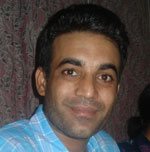
Jaswinder, or Jassi, was 25-years-old when she was kidnapped, tortured and killed in the spring of 2000 after going against her family’s wishes and marrying Mithu.
Mithu, a poor auto-rickshaw driver, was hacked by swords and left for dead after his wife was whisked away.
After several weeks in a coma, he awoke to be told that Jassi, whom he had secretly married, had been brutally slain. [link]
Punjab Police later revealed that Jassi’s family had paid up to $50,000 for the hit on their daughter. (I have commented a few times on the rise in contract killings in Punjab here and here) However, even after the death of his beloved Sukhwinder Singh “Mithu” still could not find peace. Jassi’s family was able to find a false witness, a former employee of theirs from their village, to lodge a false case against Mithu claiming that he had raped her.
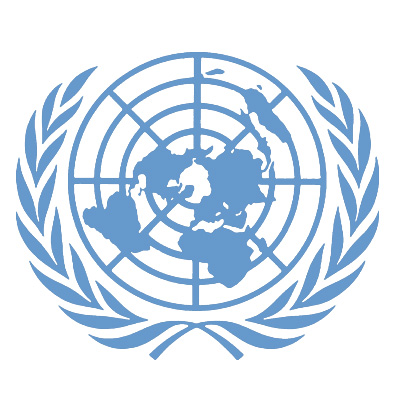 We’ve had a lot of discussion recently about various forms of identity discrimination. It seems that the UN is also paying attention to racial discrimination in the US:
We’ve had a lot of discussion recently about various forms of identity discrimination. It seems that the UN is also paying attention to racial discrimination in the US:
A U.N. expert on racism and xenophobia arrived in Washington yesterday for a three-week fact-finding visit to examine human rights lapses in the United States.
Despite Obama’s recent speech acknowledging racial tension, which was a long time coming, US representatives continue to deny that there is a problem.
“I think it’s important for the [U.N.] Human Rights Council to spend its time on real problems and the problems of violations of human rights of countries that are notorious violators,” said Zalmay Khalilzad, the U.S. ambassador to the United Nations, offering a list of suggestions. [emphasis added]
Mr. Khalilzad is well respected in comparison to his predecessor John Bolton, but that wasn’t too difficult of a feat, considering Bolton infamously stated “there is no such thing as the United Nations,” and that “the Secretariat building in New York has 38 stories. If you lost ten stories today, it wouldn’t make a bit of difference.” [link]
Mr. Khalilzad’s blatant denial of the problem of racial discrimination in the US is embarrassing, even for a diplomat. And the strategy of redirecting attention to other nations to divert attention from the very real problems at home is getting tiring- the US has no moral currency left in the international community with which to continue condemning others while allowing discrimination at home to fester.
In today’s LA Times, I read an article that I thought was just horrifying. It seems that an American soldier was using a Qur’an for target practice.
U.S. commanders moved swiftly to avert a crisis after a soldier deployed in Baghdad was found to have used a copy of the Koran for target practice.
Iraqi police found the desecrated copy of the Muslim holy book on May 11 at a small shooting range near a police station in Radwaniya, a mostly Sunni district on Baghdad’s western outskirts, Buckner said. The volume was riddled with bullets and had graffiti inside the cover. [link]
The journalist noted that the quick apology and removal of the offending soldier helped to keep various Sunni Arab alliances with the American forces intact, averting a possible disaster.
However, for me the problem runs much deeper. I cannot help but draw a link between this incident and the patka burning incident from last week. In America, there seems to be a domestic policy promoting Islamophobia. Islamophobia is not limited to merely Muslims, but includes all that have become racialized as Muslims. Sikhs fall most prominently within this category. However, while promoting this type of behavior at home, the Bush administration is trying to foster Arab and Muslim allies abroad. However, the two are linked and this accounts for another systemic failure and contradiction in the Bush doctrine.
I have mentioned Bant Singh before in a previous post, but yesterday while scouring through Youtube I came across a great video of him, his message, and his voice.

To those that may not have heard of him, Bant Singh is from a so-called lower caste background from Pind Jabhar in Zilla Mansa in Punjab. He emerged as a labor activist and became a lead figure in the Mazdoor Mukti Morcha (Laborer’s Liberation Movement).
At the vanguard of civil rights, the California Supreme Court affirmed the right to gay marriage today by overturning two of the state’s previous bans. The legislative debate over “gay marriage” (now, simply marriage) began in California in 2004, when San Francisco mayor Gavin Newsom ordered the county clerk to issue marriage licenses to same-sex couples.

Already opponents of the decision have thrown down the gauntlet, saying that they will push to place a constitutional amendment on the ballot to ban gay marriage. I say bring it on — I hope that people vote down such an obvious attempt to abrogate a decision that, at its core, is based on principles of equality. And then, I hope they gather signatures and pass a constitutional amendment UPHOLDING marriage equality, just to make it perfectly clear that voters are willing to be proactive on this issue.
I’ve made my position clear, but I have to say that I am incredibly proud and honored to be a Californian today. I remember wondering if marriage equality was something I would ever see in my own lifetime, or if it would be delayed for generations to come.
LATEST DEVELOPMENT: The Sikh Coalition, from initial press reports although not found on their website, seems to be demanding the perpetrator Garret Green should be charged as committing a hate crime.
Harsimran Kaur, staff attorney of Sikh Coalition, told IANS the school has told them that they have taken the harshest measures against the student who committed the atrocious act.
“But I am disappointed with the slow police response. The incident took place last Monday, and they interviewed the victim only Friday. They have also not taken us into confidence on the investigation,” Kaur said.[link]
The school district has objected to the label, citing the following:
Mr. Bolandi said one of the reasons district officials do not believe the incident was hate-related is that Mr. Green made no comments to the victim.
”There was no discussion at all,” he said. “The victim didn’t even know who did it. It took us an hour to figure that out, and eventually he admitted it.”
Mr. Bolandi added that Mr. Green has had previous discipline issues in school. [link]
While we’ve heard a recurrent Canadian voice that claims that Sikhi is incompatible with being openly LGBTIQ, a new Sikh-specific support group has grown in Vancouver. There have certainly been South Asian-specific support organizations in the diaspora for the last decade or so (within the U.S., Trikone in SF, and SALGA on the east coast). However, these organizations have been challenged to create space for those at the intersections of regional and religious identity — i.e., between a Punjabi/South Asian ethnic identity and a Sikh religious identity. Similar organizations have recently sprouted up in the queer (South Asian) Muslim community, but this is the first formal Sikh support group I’ve heard about.
This made me reflect on other issues of integration and advocacy across communities. I think it’s vitally important to have community organizations, in part because they play a large role in creating sustainable institutions. However, I also resent that “mainstream” organizations sometimes use these institutions as an excuse for failing to provide comprehensive services for the true diversity within a larger, umbrella community. I also worry that it’s only possible to get this level of specificity in areas where there is a large enough community to achieve a critical mass.
What do you think, readers? Would a Sher in your area provide a necessary safe space? Would it be feasible?
Previous coverage: Towards a Queer ethos, A “Sensible” Religious Response to LGBTIQ Sikhs
While Fortune Magazine used this picture in a recent advertisement for Dow Chemical Company, I first saw this image on the premiere issue of a new magazine I subscribe to. 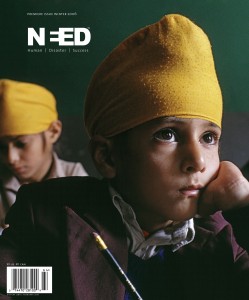 The image, by world-renowned photographer Steve McCurry, was chosen for the cover of the first issue of NEED magazine, an independent publication dedicated solely to global and domestic humanitarian issues.
The image, by world-renowned photographer Steve McCurry, was chosen for the cover of the first issue of NEED magazine, an independent publication dedicated solely to global and domestic humanitarian issues.
Steve McCurry is founder of ImagineAsia – an organization that helps children in rural Asian communities by addressing fundamental education and healthcare needs. The image, displaying Sikh children, was used to display (among other images) the pictorial state of education in Afghanistan. The education system in Afghanistan was virtually destroyed following successive wars and oppression by the Soviet Union and the Taliban. McCurry has been covering Afghanistan since before the Russian invasion in 1979. He has a unique and intimate knowledge of the country. He saw first-hand the turmoil of war and an entire generation of Afghans lose an opportunity to be educated. The result is a shattered country that ranks among the most illiterate in the world. [NEED Magazine]
Afghanistan’s children represent the country’s hopes for a better future, and education is the key to that future. The country’s new constitution makes education mandatory for children up to grade nine. This is a unique window of opportunity in Afghanistan’s history, a time when the need for education has been recognized and children are yearning to go to school. – Steve McCurry, Winter 2006 issue, NEED magazine.
You can order this issue (Winter 2006) of NEED magazine by viewing this website.
In the past few months, New America Media has reported on the treatment and exploitation of Punjabi farmworkers and the cultural isolation they are experiencing. This is not a new issue nor is it unique to Punjabi farmworkers, but it is a growing trend that is beginning to be addressed by workers’ rights organizations. One of the most recent articles by NAM speaks about the exploitation of farmworkers who are here on temporary visas.
In California’s rural Central Valley farmland, there are rumors that American farmers of Indian origin are, in an ironic twist, also abusing the temporary work visa program. In 2005, the case against a prominent Yuba City, Calif. grower, Harbans Bath, was settled in favor of his workers. He had been accused of housing hundreds of temporary workers, including some of his own relatives, in trailers, pesticide storage sheds and other structures that didn’t meet housing safety and health standards. According to Lee Pliscou, a lead attorney at California Rural Legal Assistance, the workers weren’t provided with food – instead, they were made to eat the crops they picked. They were also told that they wouldn’t be paid until the end of the harvest season. The workers from the Indian state of Punjab readily accepted this condition, since that is how payment has often worked on Punjabi farms.
An interesting statistic suggests that while South Asian growers account for less than one percent of the farmers in California, records show that they have been the targets of five percent of civil actions. Related to labor violations, Punjabi farmworkers are also experiencing cultural isolation that is adversely impacting their health. California governmental agencies that are responsible for protecting the rights of farm workers do not have Punjabi-speaking outreach workers. Many farm-working Punjabis often endure hazardous conditions, substandard pay, and little or no access to health care. Indian American growers in California have paid more than $15,000 in field violation fines to county agricultural commissioners in the past two years.
Recently on “The Langar Hall” there has been discussion about “Runaway Grooms” who with their immigration status abroad marry women from Punjab, only to abandon them after receiving the dowry. Along with being deserted by their husbands, these women’s “dreams” of going abroad are also shattered. These “dreams” were generally a primary reason many of the women were married to these men. Hasit Shah writes in his BBC news article,
“You can see it around you. There is a lot of foreign money in this city [Jalandhar]. The NRIs have been coming back and building huge houses and flaunting their success. The locals see this and want a better life for their daughters, but when the husband is unscrupulous, the women’s lives are ruined.”
Many Punjabi men in Punjab/India are also tremendously influenced by this wealth and have dreams of going abroad (a lot of it has to do with lack of job/economic opportunities in Punjab). NRI women’s green cards and citizenship status become routes for gaining permanent residency abroad. Interestingly, it is the “unscrupulousness” behavior of “husbands” and gendered power dynamics prevalent in “Runaway Groom” situations that translate into the predicaments faced by a growing number of NRI women who are also manipulated and abused by their Punjabi Sikh husbands from Punjab/India. Their “husbands” were not interested in a marriage … they really only wanted the money and permanent residency abroad. I completely agree that this is not the outcome of all NRI and non-NRI marriages. Many couples are very happy. Yes, I acknowledge that the circumstances are different for NRI and non-NRI women based on the power hierarchy between the

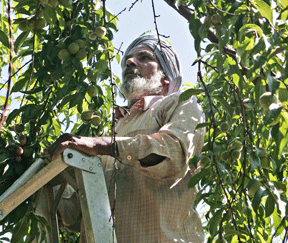 In California’s rural Central Valley farmland, there are rumors that American farmers of Indian origin are, in an ironic twist, also abusing the temporary work visa program. In 2005, the case against a prominent Yuba City, Calif. grower, Harbans Bath, was settled in favor of his workers. He had been accused of housing hundreds of temporary workers, including some of his own relatives, in trailers, pesticide storage sheds and other structures that didn’t meet housing safety and health standards. According to Lee Pliscou, a lead attorney at California Rural Legal Assistance, the workers weren’t provided with food – instead, they were made to eat the crops they picked. They were also told that they wouldn’t be paid until the end of the harvest season. The workers from the Indian state of Punjab readily accepted this condition, since that is how payment has often worked on Punjabi farms.
In California’s rural Central Valley farmland, there are rumors that American farmers of Indian origin are, in an ironic twist, also abusing the temporary work visa program. In 2005, the case against a prominent Yuba City, Calif. grower, Harbans Bath, was settled in favor of his workers. He had been accused of housing hundreds of temporary workers, including some of his own relatives, in trailers, pesticide storage sheds and other structures that didn’t meet housing safety and health standards. According to Lee Pliscou, a lead attorney at California Rural Legal Assistance, the workers weren’t provided with food – instead, they were made to eat the crops they picked. They were also told that they wouldn’t be paid until the end of the harvest season. The workers from the Indian state of Punjab readily accepted this condition, since that is how payment has often worked on Punjabi farms.